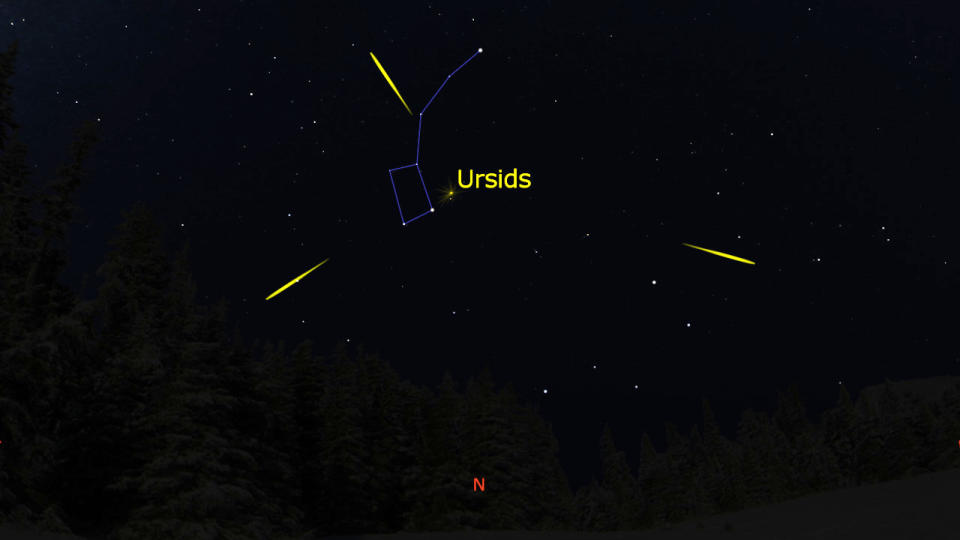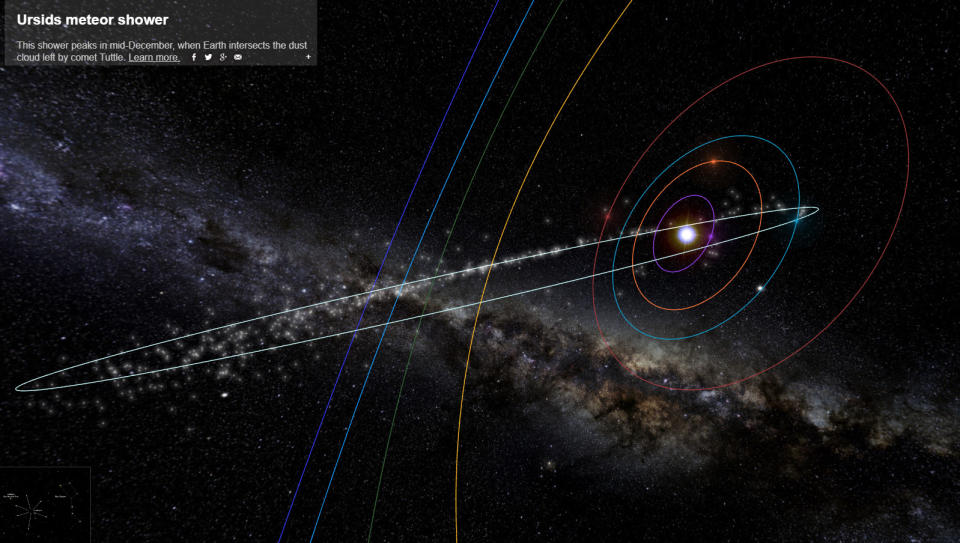Rare outburst possible from the Ursid meteor shower tonight!

On the first night of winter, find a clear view of the sky and look up. There's a chance to see bright meteors flashing by overhead.
Each year, meteors flash through the night from mid-to-late December, appearing from within the Little Dipper, located in the northern sky. This is the annual Ursid meteor shower.

The radiant of the Ursid meteor shower, just after sunset in the northern sky. Since the Little Dipper remains above the horizon from dusk until dawn, the meteor shower will be visible all night long. Credit: Stellarium/Scott Sutherland
Originating from comet 8P/Tuttle and named for the constellation Ursa Minor, the Ursids are usually one of the weakest meteor showers of the year. Even under ideal conditions and during the peak of its activity (around December 21), it only produces about 10 meteors per hour.
To see the Ursids, try to avoid urban light pollution and find a place with a good view of the northern sky. Read on for more tips on getting the most out of the event.
The Ursids in 2022
Two things make this year an excellent time to observe the Ursids.
First, the meteor shower's peak, on the night of December 21, is timed exceptionally well, as it occurs during the New Moon. Given that the light of the Moon can reduce the number of meteors we can see, a New Moon maximizes our viewing potential for this meteor shower.
Second, there's a chance Earth will pass through two different concentrations of meteoroids that are embedded in Comet Tuttle's debris stream. If so, there will be short outbursts when the number of Ursids we see jumps by two or three times the normal amount.

The debris stream of comet 8P/Tuttle in the inner solar system. Earth's orbit is in blue. Credit: Peter Jenniskens/meteorshowers.org
The particles of dust and ice in a comet's debris stream are usually fairly spread out. However, due to either the comet's behaviour, or how gravity and solar radiation pressure affect the comet's stream over time, concentrated bands of material can form within the stream. Some are known as filaments. Others are called dust trails.
According to the International Meteor Organization, NASA scientist Peter Jenniskens has predicted an encounter with a filament in the Ursid stream, occurring around 10:22 UTC on December 22.
For viewers across Canada, this timing translates to Thursday morning at:
6:52 a.m. NST,
6:22 a.m. AST,
5:22 a.m. EST,
4:22 a.m. CST,
3:22 a.m. MST, and
2:22 a.m. PST.
Jenniskens' research suggests that the number of meteors seen could jump to more than double the standard rate around that time.
Japanese meteor expert Mikiya Sato discovered another potential outburst, as our planet may sweep through a dust trail that the comet ejected back in the year 843.
While there's no way to know exactly how many meteors will be produced by this dust trail, Sato's timing for the event puts it around 4 hours after the 'filament encounter' predicted by Jenniskens (at 14:22 UTC, 7:22 a.m. MST, 6:22 a.m. PST). That means it is well-timed for observers in Alberta, British Columbia, Yukon, and western Northwest Territories.
There's no guarantee that these outbursts will occur. As Robert Lunsford noted on the American Meteor Society website: "the timing is easier to predict than the density of the dust trails."
Overall, give yourself a reasonable amount of time to observe the meteor shower — around 20-30 minutes to let your eyes adjust to the dark and then at least 30-60 minutes after that to spot meteors.
Tips for meteor shower watching
Meteor showers are events that nearly everyone can watch. No special equipment is required. In fact, looking through binoculars or a telescope makes it harder to see a meteor shower, as they limit how much of the sky you can see at once. However, there are a few things to remember so you can experience these fantastic events.
The three best practices for observing the night sky are:
Check the weather,
Get away from light pollution, and
Be patient.
Clear skies are essential. Even a few hours of cloudy skies can ruin your chances of watching an event such as a meteor shower. So, be sure to check The Weather Network on TV, on our website, or from our app, and look for my articles on our Space News page, just to be sure that you have the most up-to-date sky forecast.
Next, you need to get away from city light pollution. What do you see if you look up at the sky from home? The Moon, a planet or two, a few bright stars such as Vega, Betelgeuse and Procyon, and some passing airliners? If so, your area has too much light pollution to get the most out of a meteor shower. Of course, you might catch an exceptionally bright fireball if one flies past overhead, but that's likely all you'll see. So, get out of the city to get the most out of your meteor watching. The farther away you can get, the better.
Watch: What light pollution is doing to city views of the Milky Way
For most regions of Canada, getting out from under light pollution is simply a matter of driving outside of your city, town or village until a multitude of stars is visible above your head.
In some areas, especially in southern Ontario and along the St. Lawrence River, the concentration of light pollution is too high. Getting far enough outside of one city to escape its light pollution tends to put you under the light pollution dome of the next city over. The best options for getting away from light depend on your location. In southwestern Ontario and the Niagara Peninsula, the shores of Lake Erie can offer some excellent views. In the GTA and farther east, drive north and seek out the various Ontario provincial parks or Quebec provincial parks. Even if you're confined to the parking lot after hours, these are usually excellent locations from which to watch (and you don't run the risk of trespassing on someone's property).
If you can't get away, the suburbs can offer at least a slightly better view of the night sky. Here, the key is to limit the amount of direct light in your field of view. Dark backyards, sheltered from street lights by surrounding houses and trees, are your best haven. The video above provides a good example of viewing based on the concentration of light pollution in the sky. Also, check for dark sky preserves in your area.
When viewing a meteor shower, be mindful of the phase of the Moon. Meteor showers are typically at their best when viewed during the New Moon or Crescent Moon. However, a Gibbous or Full Moon can be bright enough to wash out all but the brightest meteors. Since we can't get away from the Moon, the best option is to time your outing for when the Moon has already set or is low in the sky. Also, you can angle your field of view to keep the Moon out of your direct line of sight. This will reduce its impact on your night vision and allow you to spot more meteors.
Once you've verified you have clear skies and limited your exposure to light pollution, this is where being patient comes in.
For best viewing, your eyes need time to adapt to the dark. Give yourself at least 20 minutes, but 30-45 minutes is best for your eyes to adjust from exposure to bright light.
Note that this, likely more than anything else, is the one thing that causes the most disappointment when it comes to watching a meteor shower.
If you step out into your backyard from a brightly lit home and look up for only a few minutes, you might get lucky and spot an exceptionally bright meteor. However, it's far more likely that you won't see any at all. This is because while meteors may be streaking overhead, it takes time for our eyes to adjust to pick out those brief flashes of light.
Waiting for at least twenty minutes, while avoiding sources of light during that time (streetlights, car headlights and interior lights, and smartphone and tablet screens) dramatically improves your chances of avoiding disappointment.
Sometimes, avoiding your smartphone or tablet isn't an option. In this case, set the display to reduce the amount of blue light it gives off and reduce the screen's brightness. That way, it will have less of an impact on your night vision.
You can certainly gaze into the starry sky while letting your eyes adjust. You may even see a few brighter meteors as your eyes become accustomed to the dark.
Once you're all set, look up and enjoy the view!
(Thumbnail courtesy of Pexels)

